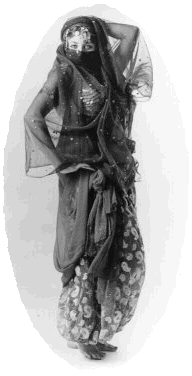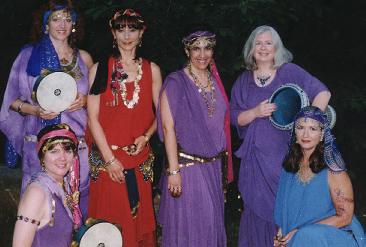Repertoire

TAHYA presents . . .
TAHYA presents = concerts treating audiences to an expansive view of the richness of Middle and Far Eastern Dance - from the faithful renditions of traditional dances to innovative combinations of oriental movement. From a pharaonic dance inspired by ancient paintings, through folk dances developed and preserved through the centuries to the present day form of the dance with its new trends and directions, the dances, choreography, and costumes of the show are partly authentic and partly the product of interpretation. This program is an exciting, exotic journey guaranteed to educate, fascinate, and entertain.
"Tahya graced the stage with her elegance...and captured the essence of Rimsky-Korsakov's Sheherazade music with a wonderful sense of style."
- Paul H. Chou, Director, Lehigh University Philharmonic Orchestra, Bethlehem, PA
"...dancer extraordinaire Tahya dazzled the crowd. The combination of strong musical numbers selected and considerable stage presence added an elegant component. Her dance activated the space... I highly recommend Tahya."
- Tom Katsimpalis, Curator of Interpretation, Loveland Museum/Gallery, Loveland, CO
REPERTOIRE:
Ancient Egyptian Images
Dancing is the oldest and liveliest of the arts. People in all countries and in all times have expressed their feeling in rhythm and body movement. When studying the development of dance, records of Egyptian dance date back at least 2000 years BCE. This dance was inspired by Egyptian hieroglyphics.
Choreography: Tahya
Costuming: Ellen Laincz
Persian
Graceful hand and arm movements define the poetry of Persian dance.
Choreography & Costuming: Tahya
Performed by: Tahya
Sword
Picture visions of ancient battles and the women who waited for the return of their men from the battlefield...Festive gatherings marked the soldiers return. The sword, once used in battle, was now used to celebrate the homecoming. Skill and concentration are the essence of the dancer who can performed the sword dance. Jean-Leon Gerome painted such a scene in his oil painting entitled 'An almeh performing the sword dance' c. 1870 (Herbert & Johnson Museum, Cornell University, New York).
Choreography & Costuming: Tahya

Mach Mach
A popular number in the ensemble's repertoire, this dance is performed to intriguing 6/8 rhythm, one of the typical folk rhythms of Morocco.
Choreography: Tahya
Costuming: Ellen Laincz
Raks al Assaya
An Egyptian dance tradition, the "Cane dance" became most popular because of the stick's widespread use from ancient times for walking, plowing and striking The word "Assaya" does not mean "cane" but signifies a small or large stalk of bamboo. This large stick is used by the Saidi men in the "Raks Tahteeb" (stick dance of combat), consider the "father of the modern cane dance." The wild combative dance, however, has given way to a softer, more stylized form since adapted the repertoire of female dancers.
Choreography & Costuming: Tahya
Bollywood
Bollywood Dance is inspired by the song and dance sequences found in Bollywood films mingling elements of traditional Indian dance with a little jazz, modern, and Danse Orientale.
Choreography & Costuming: Tahya
Karislama
This dance depicts expressive, outgoing gypsy style to the Turkish 9/8 rhythm.
Choreography inspired by: Dalia Carella
Costuming: Ellen Laincz
Classical Lebanese Hand Dance
Set to the music of Marcel Khalifa, this dance is the story of Lulu and a bird who escaped from a cage but whose wings were damaged. Lulu encourages the bird: "Look to the sun -- see freedom shining."
Choreography: Tasha Banat
Tunisian Women's Dance
This dance was documented in 1974 by Mardi Rollow (artistic director of the LA based AMAN company) who was given a grant to do field work in Tunisian and Morocco. In the small towns of Tunisia, song and dance have an important place not only at festivities but at home with family and friends as well. The traditional women's dance is characterized by vigorous horizontal movements of the hips and dancer's hands facing outward to show off her beautifully henna-decorated palms!
Choreography & costuming: Traditional
Oriental Cabaret
Soft and flowing like a dream from Arabian Nights , the use of the veil is both beautiful and mysterious. The veil is perceived as a continuation of the body as it is gracefully moved through the air. Hip articulation and isolated torso movements mark the dynamic drum section of this dance. Middle Eastern Dance, unlike ballet and other dance forms, allows solo performers full freedom to respond to the music in individual interpretation true to their own personalities and creative talents.
Choreography: Tahya
Percussion Processional
Inspired by Layne Redmond's work, Troupe Bannat Tahya of the Lehigh Valley have choreographed a percussion processional, a tribute to ancient rituals when the "Women were Drummers." An inspired invocation for any auspicious occasion the troupe, attired in beautiful multi-layered dresses of rich colors, brings together the sounds of riqq, finger cymbals, dumbek and bell in combination with choreorgraphed movements steeped in antiquity to arise and celebrate the Divine within!
Choreography: Tahya

Poised to present the percussion processional at '99 Unity with a Beat Retreat:
Diselle, Tahya, Donna, Silvana, Meghar, and Phaedra
Ensemble Information:
TAHYA, a spellbinding performer, has been devoted to presenting as well as teaching dances steeped in antiquity for over 20 years. Striving to preserve the cultural form of North African and Mediterranean cultures, "Tahya can transform any school assembly or concert hall into another time and place with her artistry. I have performed with her and she is a true artist as well as a gifted communicator," David Amram, internationally-acclaimed composer/conductor/multi-instrumentalist.
TROUPE BANNAT TAHYA consists of women who have been studying with Tahya and have demonstrated the interest, enthusiasm and expertise necessary to participate in group choreography. The ensemble members vary depending on family and/or professional obligations.
Experience the wonder of an ancient and enduring art.
Discover the mystique of traditions steeped in ritual.
